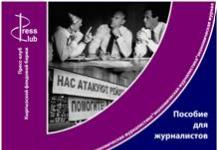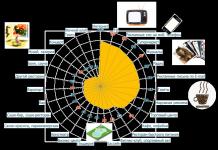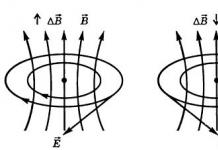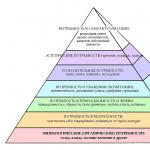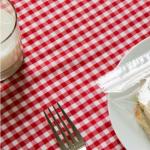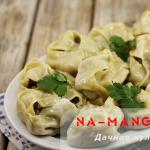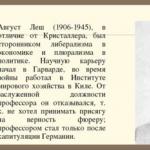This standard applies to non-galvanized and galvanized steel welded pipes with cut or rolled cylindrical threads and without threads, used for water and gas pipelines, heating systems, as well as for parts of water and gas pipeline structures.
| Designation: | GOST 3262-75* |
| Russian name: | Steel water and gas pipes. Specifications |
| Status: | active |
| Replaces: | GOST 3262-62 |
| Date of text update: | 01.10.2008 |
| Date added to the database: | 01.02.2009 |
| Effective date: | 01.01.1977 |
| Designed by: | Ministry of Ferrous Metallurgy of the USSR |
| Approved: | USSR State Committee for Standards (09/11/1975) |
| Published: | Publishing house of standards No. 1994 |
STEEL WATER AND GAS PIPES
TECHNICAL CONDITIONS
GOST 3262-75
PUBLISHING HOUSE OF STANDARDS
Moscow
STATE STANDARD OF THE USSR UNION
Dateintroduction 01.01.77
This standard applies to non-galvanized and galvanized steel welded pipes with cut or rolled cylindrical threads and without threads, used for water and gas pipelines, heating systems, as well as for parts of water and gas structures.
1. ASSORTMENT
1.1. Pipes are manufactured according to the dimensions and weight given in table. 1.
At the consumer's request, light series pipes intended for thread rolling are manufactured according to the dimensions and weight given in table. 2.
(Changed edition, Rev. No. 1 , 3 ).
1.2. The length of the pipe is made from 4 to 12 m:
measured or multiple measured length with an allowance for each cut of 5 mm and a maximum deviation for the entire length plus 10 mm;
By agreement between the manufacturer and the consumer, up to 5% of pipes with a length of 1.5 to 4 m are allowed in a batch of unmeasured pipes.
Table 1
Dimensions, mm
| Conditional passage | Pipe wall thickness | Weight of 1 m of pipes, kg |
|||||
| ordinary | reinforced | ordinary | reinforced |
||||
Table 2
Dimensions, mm
| Conditional passage | O.D | Wall thickness | Weight of 1 m of pipes, kg |
Notes:
1. For threads made by rolling on a pipe, its internal diameter is allowed to be reduced by up to 10% along the entire length of the thread.
2. The weight of 1 m of pipes is calculated at a steel density of 7.85 g/cm 3. Galvanized pipes are 3% heavier than non-galvanized ones.
1.3. Maximum deviations in pipe sizes should not exceed those indicated in the table. 3.
Table 3
| Pipe sizes | Limit deviations for manufacturing precision pipes |
|
| increased |
||
| Outer diameter with nominal bore: | ||
| up to 40 mm incl. | ||
| - 0,5 |
||
| Outer diameter with nominal bore: over 40 mm | ||
| - 1,0 |
||
| Wall thickness | - 15 % | - 10 % |
Notes:
1. Maximum deviation the plus side of the wall thickness is limited by the maximum deviations in the weight of the pipes.
2. Pipes of standard manufacturing precision are used for water supply, gas pipelines and heating systems. Pipes with increased manufacturing precision are used for parts of water and gas pipeline structures.
1.4. Maximum deviations in the mass of pipes should not exceed +8%.
At customer's request maximum deviations by weight should not exceed:
7.5% - for the party;
10% - for a separate pipe.
(Changed edition, Amendment No. 2, 5).
1.5. The curvature of pipes per 1 m of length should not exceed:
2 mm - with nominal bore up to 20 mm inclusive;
1.5 mm - with a nominal bore of more than 20 mm.
1.6. Pipe threads can be long or short. The thread requirements must correspond to those indicated in the table. 4.
| Conditional bore, mm | Thread length before run-out, mm | Conditional bore, mm | Number of threads at nominal size | Thread length before run-out, mm |
|||
| short | short |
||||||
1.7. Pipes with a nominal bore of 6, 8, 10, 15 and 20 mm are wound into coils at the consumer’s request.
Examples of symbols
An ordinary pipe, non-galvanized, of normal manufacturing precision, of unmeasured length, with a nominal bore of 20 mm, a wall thickness of 2.8 mm, without threads and without a coupling:
Pipe 20´ 2.8 GOST 3262-75
The same with the coupling:
Pipe M-20´ 2.8 GOST 3262-75
The same, measured length, thread:
Pipe R-20´ 2.8 - 4000 GOST 3262-75
The same, with zinc coating, of unmeasured length, with thread:
Pipe Ts-R-20´ 2.8 GOST 3262-75
The same, with zinc coating, measured length, with thread:
Pipe Ts-R-20´ 2.8 - 4000 GOST 3262-75
For pipes with rolling threads symbol After the word “pipe” the letter N is indicated.
For pipes with long threads, the letter D is indicated after the word “pipe” in the symbol.
For pipes with increased manufacturing precision, the letter P is indicated in the symbol after the size of the nominal bore.
(Changed edition, Amendment No. 1).
2. TECHNICAL REQUIREMENTS
2.1. Pipes are manufactured in accordance with the requirements of this standard and according to technological regulations approved in the prescribed manner, from steels in accordance with GOST 380 and GOST 1050 without standardization of mechanical properties and chemical composition.
Pipes for parts of water and gas structures are made of steel in accordance with GOST 1050.
2.2. At the request of the consumer, the ends of pipes to be welded with a wall thickness of 5 mm or more must be chamfered at an angle of 35-40 ° to the end of the pipe. In this case, an end ring 1 - 3 mm wide should be left.
At the request of the consumer, on ordinary and reinforced pipes with a nominal bore of more than 10 mm, threads are applied to both ends of the pipe.
2.1; 2.2. (Changed edition, Amendment No. 3, 4).
2.3. At the request of the consumer, pipes are equipped with couplings manufactured in accordance with GOST8944, GOST8954, GOST8965 and GOST8966 at the rate of one coupling for each pipe.
(Changed edition, Amendment No. 3).
2.4. Cracks, spots, swellings and declines are not allowed on the surface of the pipes.
Delaminations are not allowed at the ends of the pipes.
Individual dents, ripples, scratches, traces of stripping and other defects caused by the production method are allowed, if they do not take the wall thickness beyond the minimum dimensions, as well as a layer of scale that does not interfere with inspection.
On pipes made by furnace welding, it is allowed to reduce the outer diameter to 0.5 mm at the seam if there is a gentle thickening in this place along the inner diameter of no more than 1.0 mm.
(Changed edition, Amendment No. 3, 4).
2.5. At the request of the consumer, on pipes with a nominal bore of 20 mm or more, the burr on the inner surface of the pipe seam must be cut off or flattened, and the height of the burr or its traces should not exceed 0.5 mm.
At the request of the consumer, on pipes with a nominal bore of more than 15 mm, manufactured by furnace welding and hot reduction, a gentle thickening with a height of no more than 0.5 mm is allowed on the inner surface of the pipes in the weld zone.
(Changed edition, Amendment No. 2, 3, 4, 5, 6).
2.6. The ends of the pipes must be cut at right angles. The allowed end bevel value is no more than 2 ° .The remaining burrs should not exceed 0.5 mm. When removing burrs, blunting (rounding) of the ends is allowed. It is allowed to cut pipes in the mill line.
By agreement between the manufacturer and the consumer, burrs up to 1 mm are allowed on pipes with a nominal bore of 6-25 mm, manufactured by furnace welding.
(Changed edition, Amendment No. 4, 6).
2.7. Galvanized pipes must have a continuous zinc coating over the entire surface with a thickness of at least 30 microns. The absence of zinc coating on the ends and threads of pipes is allowed.
On the surface of galvanized pipes, bubbles and foreign inclusions (hartzinc, oxides, sintered mixture), and peeling of the coating from the base metal are not allowed.
Individual flux stains and traces of pipes being caught by lifting devices, roughness and minor local deposits of zinc are allowed.
It is allowed to correct individual non-galvanized areas on 0.5% of the outer surface of the pipe in accordance with GOST 9.307.
(Changed edition, Amendment No. 3, 4).
2.8. Pipes must withstand hydraulic pressure:
2.4 MPa (25 kgf/cm 2) - pipes, ordinary and light;
3.1 MPa (32 kgf/cm 2) - reinforced pipes.
At the consumer's request, the pipes must withstand hydraulic pressure of 4.9 MPa (50 kgf/cm2)
2.9. Pipes with a nominal bore up to 40 mm inclusive must withstand the bend test around a mandrel with a radius equal to 2.5 outer diameters, and with a nominal bore of 50 mm - on a mandrel with a radius equal to 3.5 outer diameters.
At the consumer's request, pipes must withstand the distribution test:
for pipes with a nominal bore from 15 to 50 mm - no less than 7%;
for pipes with a nominal bore of 65 or more - no less than 4%.
At the consumer's request, pipes must withstand the flattening test to a distance between the flattened surfaces equal to 2/3 of the outer diameter of the pipes.
2.8,2.9. (Changed edition, Amendment No. 2, 3, 5).
2.10. At the request of the consumer, the mechanical properties of pipes for parts of water supply and gas structures must comply with GOST 1050.
2.11. Pipe threads must be clean, without flaws or burrs and comply with GOST 6357, accuracy class B.
Pipes with cylindrical threads are used when assembling with seals.
2.10; 2.11. (Changed edition, Amendment No. 3, 4).
2.12. Blackness on the threads is allowed in the place of shwad if the reduction in the normal height of the thread profile does not exceed 15%, and at the request of the consumer does not exceed 10%.
Threads with torn (for cut) or incomplete (for rolled) threads are allowed on threads, provided that their total length does not exceed 10% of the required thread length, and at the request of the consumer does not exceed 5%.
2.13. For threads, it is allowed to reduce the useful length of the thread (without run-out) by up to 15% compared to that specified in, and at the request of the consumer up to 10%.
2.12.,2.13. (Changed edition, Amendment No. 2, 3, 5).
2.14. Threading of galvanized pipes is carried out after galvanizing.
2.15. (Deleted, Amendment No. 3).
2.16. At the request of the consumer, pipe welds are subjected to inspection non-destructive methods.
(Changed edition, Amendment No. 5).
3. ACCEPTANCE RULES
3.1. Pipes are accepted in batches. The batch must consist of pipes of the same size, the same brand and be accompanied by one quality document in accordance with GOST 10692 with the addition for pipes intended for the manufacture of parts for water and gas structures, made of steel according to GOST1050: chemical composition and mechanical properties of steel in accordance with the document on the quality of the workpiece manufacturer.
The batch weight is no more than 60 tons.
(Changed edition, Amendment No. 3, 4).
3.2. Each batch of pipes is subjected to inspection of the surface, dimensions and curvature.
Allowed to use statistical methods control according to GOST 18242 with a normal level. Control plans are established by agreement between the manufacturer and the consumer.
Inspection of the outer diameter of pipes is carried out at a distance of at least 15 mm from the end of the pipe.
(Changed edition, Amendment No. 3, 4, 5).
3.3. To control the parameters of the thread, to test for expansion, flattening, bending, the height of the internal burr, the remains of burrs, the right angle and the chamfer angle (for pipes with beveled edges), mechanical properties, no more than 1%, but not less than two pipes from the batch, are selected, and for pipes manufactured by continuous furnace welding - two pipes per batch.
(Changed edition, Amendment No. 3, 4).
3.4. All pipes are subject to weight control.
(Changed edition, Amendment No. 3).
3.5. Each pipe is subjected to hydraulic pressure testing. With 100% quality control of the weld using non-destructive methods, hydraulic pressure testing may not be carried out. At the same time, the ability of the pipes to withstand the test hydraulic pressure is guaranteed.
(Changed edition, Amendment No. 6).
3.6. To check the thickness of the zinc coating on the outer surface and in accessible places on the inner surface, two pipes from the batch are selected.
(Changed edition, Amendment No. 2).
3.7. If unsatisfactory test results are obtained for at least one of the indicators, a repeat test is carried out on a double sample.
The results of repeated tests apply to the entire batch.
4. TEST METHODS
4.1. For quality control, one sample is cut from each selected pipe for each type of test.
The tensile test is carried out in accordance with GOST 10006. Instead of the tensile test, it is allowed to control the mechanical properties by non-destructive methods.
4.2. Inspection of the pipe surface is carried out visually.
4.3. Hydraulic testing is carried out according to GOST 3845 with exposure to test pressure at least 5 s.
4.4. The bend test is carried out according to GOST 3728. Galvanized pipes are tested before coating.
(Changed edition, Amendment No. 3).
4.4a. The expansion test is carried out according to GOST 8694 on a conical mandrel with a taper angle of 6 ° .
It is allowed to test on a mandrel with a taper angle of 30 ° .
(Changed edition, Amendment No. 3, 4).
4.4b. The flattening test is carried out according to GOST 8695.
(Changed edition, Amendment No. 3).
4.4v. Weld inspection is carried out using non-destructive methods according to regulatory and technical documentation.
(Introduced additionally, Amendment No. 3).
4.5. The thickness of the zinc coating on the outer surface and in accessible places on the inner surface is controlled in accordance with GOST 9.301 and GOST 9.302, as well as with instruments of the MT-41NTs, MTZON or “Impulse” type according to the regulatory and technical documentation.
4.6. The thread is checked using thread ring gauges in accordance with GOST 2533 (third class of accuracy).
In this case, the screwability of the non-go-through ring gauge onto the thread should be no more than three turns.
(Changed edition, Amendment No. 3, 4).
4.7. The curvature of the pipes is controlled using a straight edge in accordance with GOST 8026 and a set of feelers according to ND.
(Changed edition, Amendment No. 3, 5).
4.8. The right angle of the pipe ends is controlled with a 90 square ° size 160´ 100 mm class 3 GOST 3749, plate probes set 4 according to ND or inclinometer GOST 5378. The bevel angle is controlled with a protractor according to GOST 5378.
(Changed edition, Amendment No. 3, 6).
4.9. The outer diameter is checked using smooth micrometers in accordance with GOST 6507, clamp gauges in accordance with GOST 2216 or GOST 18360.
The wall thickness, the height of the internal burr and the height of the burrs are measured with a micrometer according to GOST 6507-90 or a wall gauge according to GOST 11358 from both ends of the pipe.
The length of the pipes is measured with a tape measure according to GOST 7502. The threads are controlled with gauges according to GOST 2533.
The mass of a batch of pipes is controlled on scales of no more than 10 tons with a division value of no more than 20 kg.
(Changed edition, Amendment No. 3, 4, 5, 6).
4.10. Weld inspection is carried out using non-destructive methods according to technical documentation.
(Introduced additionally, Amendment No. 4).
5. LABELING, PACKAGING, TRANSPORTATION AND STORAGE
5.1. Labeling, packaging, transportation and storage are carried out in accordance with GOST 10692 with an addition.
5.1.1. Pipe threads must be protected from mechanical damage and corrosion with lubricant according to regulatory and technical documentation.
Sec. 5. (Changed edition, Amendment No. 3).
INFORMATION DATA
1. DESIGNED AND INTRODUCED by the Ministry ferrous metallurgy of the USSR
DEVELOPERS
V. I. Struzhok, Ph.D. tech. sciences, V. M. Vorona, Ph.D. tech. sciences, Yu. M. Mironov, Ph.D. tech. nook, A. I. Postolova
2. APPROVED AND PUSHED INTO EFFECT by the Resolution State Committee USSR according to standards from 09.11.75 No. 2379
3. Inspection frequency 5 years
4. INSTEAD GOST3262-62
5. REFERENCE REGULATIVE AND TECHNICAL DOCUMENTS
| Item number |
|
| GOST 9.301-86 | |
| GOST 9.302-88 | |
| GOST 9.307-89 | |
| GOST 380- 94 | |
| GOST 1050-88 | |
| GOST 2216-84 | |
| GOST 2533-88 | |
| GOST 3728-78 | |
| GOST 3749-77 | |
| GOST 3845-75 | |
| GOST 5378-88 | |
| GOST 6357-81 | |
| GOST 6507-90 | |
| GOST 7502-89 | |
| GOST 8026-92 | |
| GOST 8694-75 | |
| GOST 8695-75 | |
| GOST 8944-75 | |
| GOST 8954-75 | |
| GOST 8965-75 | |
| GOST 8966-75 | |
| GOST 10006-80 | |
| GOST 10692-80 | |
| GOST 11358-89 | |
| GOST 18242-72 | |
| GOST 18360 -9 3 |
6. Validity restrictions were removed by Gosstandart Decree dated November 12, 1991 No. 1726
7. Reissue with Amendments No. 1, 2, 3, 4, 5, 6, approved in November 1977, December 1978, January 1987, May 1988, November 1989, November 1991 (IUS 1 -78.2-79, 4-87, 8-88, 2-90, 2-92)
Electric-welded straight-seam GOST 3262 are electric-welded pipes that are used to create heating and water supply systems, as well as gas pipelines. The requirements specified in the regulations apply to steel products, which may or may not have threads and galvanized coating. thin-walled and thick-walled have wide area applications thanks to good technical specifications and low cost. With their help, it is possible to implement almost any project to supply a building with utility networks.
Types of VGP pipes
The presented type of rolled metal is produced with a length from 4 to 12 m. They can be divided into VGP pipes measured and unmeasured lengths. Depending on the conditional passage, they can be wound into coils. Besides, hardware This type is divided into the following types:
- pipes of ordinary precision are produced without standardization of the composition of mechanical properties;
- high-precision pipes, the creation of which complies with GOST 1050-88 standards.
Products are divided into thick-walled and thin-walled steel pipes depending on the wall thickness. Experts often divide them into light, ordinary and enhanced on a similar basis. Buyers should carefully read the product characteristics, as this will affect the operation process in the future. Incorrect selection and installation can result in premature system failure and the need for immediate repairs.
Advantages of VGP pipes
It is important to buy water and gas pipes for housing and communal services, owners of private houses and enterprises. They have the following advantages:
- high quality of workmanship and absence of defects;
- possibility of choosing products with suitable diameter, size and weight;
- ease of installation is ensured by the use of welding;
- materials are resistant to corrosion, chemical and mechanical stress;
- high strength and absence of deformation;
- long service life;
- ease of transportation and storage;
- affordable price.
Anyone can acquire rolled metal of the presented type, wholesale or retail, choosing it in accordance with its purpose. The terms of delivery of goods are guaranteed to satisfy all buyers.
INTERSTATE STANDARD
TECHNICAL CONDITIONS
Official publication
Standardinform
UDC 669.14-462:006.354
INTERSTATE
Group B62
STANDARD
STEEL WATER AND GAS PIPES
Specifications
Water-supply and gas-supply steel pipes. Specifications
MKS 23.040.10 OKP 13 8500, 13 8501
Date of introduction 01/01/77
This standard applies to non-galvanized and galvanized steel welded pipes with cut or rolled cylindrical threads and without threads, used for water and gas pipelines, heating systems, as well as for parts of water and gas pipeline structures.
(Changed edition, Amendment No. 2, 3, 5).
1. ASSORTMENT
1.1. Pipes are manufactured according to the dimensions and weight given in table. 1.
At the consumer's request, light series pipes intended for thread rolling are manufactured according to the dimensions and weight given in table. 2.
(Changed edition, Amendment No. 1, 3).
1.2. The length of the pipe is made from 4 to 12 m:
measured or multiple measured length with an allowance for each cut of 5 mm and a longitudinal deviation over the entire length plus 10 mm;
of unmeasured length.
By agreement between the manufacturer and the consumer, up to 5% of pipes with a length of 1.5 to 4 m are allowed in a batch of unmeasured pipes.
Official publication
Reproduction is prohibited
© Standards Publishing House, 1976 © Standartinform, 2007
Dimensions, mm
Table 1
|
Pipe wall thickness |
Weight of 1 m of pipes, kg |
||||||
Table 2 Dimensions, mm
Notes:
1. For threads made by rolling on a pipe, its internal diameter is allowed to be reduced by up to 10% along the entire length of the thread.
2. The mass of 1 m of pipes is calculated at a steel density of 7.85 g/cm 3 . Galvanized pipes are 3% heavier than non-galvanized ones.
1.3. Maximum deviations in pipe sizes should not exceed those indicated in the table. 3.
Table 3
Notes:
1. The maximum deviation in the positive direction for wall thickness is limited by the maximum deviations for the mass of the pipes.
2. Pipes of standard manufacturing precision are used for water supply, gas pipelines and heating systems. Pipes with increased manufacturing precision are used for parts of water and gas pipeline structures.
1.4. Maximum deviations in the mass of pipes should not exceed +8%.
At the request of the consumer, maximum deviations in mass should not exceed:
7.5% - for the party;
10% - for a separate pipe.
(Changed edition, Amendment No. 2, 5).
1.5. The curvature of pipes per 1 m length should not exceed:
2 mm - with nominal bore up to 20 mm inclusive;
1.5 mm - with a nominal bore over 20 mm.
1.6. Pipe threads can be long or short. The thread requirements must correspond to those indicated in the table. 4.
Table 4
|
Conditional bore, mm |
Thread length before run-out, mm |
Conditional bore, mm |
Number of threads at nominal size |
Thread length before run-out, mm |
|||
|
short |
short |
||||||
Pipes with a nominal bore of 6, 8, 10, 15 and 20 mm, at the request of the consumer, are wound into Examples of symbols
An ordinary pipe, non-galvanized, of normal manufacturing precision, of unmeasured length, with a nominal bore of 20 mm, a wall thickness of 2.8 mm, without threads and without a coupling:
Pipe 20x2.8 GOST 3262-75
The same with the coupling:
Pipe M-20 x 2.8 GOST 3262-75 The same, measured length, with thread:
Pipe R-20x 2.8-4000 GOST 3262-75 The same, with zinc coating, of unmeasured length, with thread:
Pipe Ts-R-20x 2.8 GOST 3262-75 The same, with zinc coating, measured length, with thread:
Pipe Ts-R-20x 2.8-4000 GOST3262-75
For pipes for rolling threads, the letter N is indicated in the symbol after the word “pipe”.
For pipes with long threads, the letter D is indicated in the symbol after the word “pipe”. For pipes with increased manufacturing precision, the letter P is indicated in the symbol after the size of the nominal bore.
(Changed edition, Amendment No. 1).
2. TECHNICAL REQUIREMENTS
2.1. Pipes are manufactured in accordance with the requirements of this standard and according to technological regulations, approved in the prescribed manner, from steels in accordance with GOST 380 and GOST 1050 without standardization of mechanical properties and chemical composition.
Pipes for parts of water supply and gas pipeline structures are made of steel in accordance with GOST 1050.
2.2. At the request of the consumer, the ends of pipes to be welded with a wall thickness of 5 mm or more must be chamfered at an angle of 35°-40° to the end of the pipe. In this case, an end ring 1-3 mm wide should be left.
At the request of the consumer, on ordinary and reinforced pipes with a nominal bore of more than 10 mm, threads are applied to both ends of the pipe.
2.1, 2.2. (Changed edition, Amendment No. 3, 4).
2.3. At the request of the consumer, pipes are equipped with couplings manufactured in accordance with GOST 8944, GOST 8954, GOST 8965 and GOST 8966, at the rate of one coupling for each pipe.
(Changed edition, Amendment No. 3).
2.4. Cracks, spots, swellings and declines are not allowed on the surface of the pipes.
Delamination is not allowed at the ends of the pipes.
Individual dents, rippling, scratches, traces of stripping and other defects caused by the production method are allowed if they do not exceed the wall thickness minimum dimensions, as well as a layer of scale that does not interfere with inspection.
On pipes made by furnace welding, it is allowed to reduce the outer diameter to 0.5 mm at the seam if there is a gentle thickening in this place along the inner diameter of no more than 1.0 mm.
(Changed edition, Amendment No. 3, 4).
2.5. At the request of the consumer, on pipes with a nominal bore of 20 mm or more, the burr on the inner surface of the pipe seam must be cut off or flattened, and the height of the burr or its traces should not exceed 0.5 mm.
At the request of the consumer, on pipes with a nominal bore of more than 15 mm, manufactured by furnace welding and hot reduction, a gentle thickening with a height of no more than 0.5 mm is allowed on the inner surface of the pipes in the weld area.
(Changed edition, Amendment No. 2, 3, 4, 5, 6).
2.6. The ends of the pipes must be cut at right angles. The bevel of the end is allowed to be no more than 2°. The remaining burrs should not exceed 0.5 mm. When removing burrs, the formation of blunting (rounding) of the ends is allowed. It is allowed to cut pipes in the mill line.
By agreement between the manufacturer and the consumer, burrs up to 1 mm are allowed on pipes with a nominal bore of 6-25 mm, manufactured by furnace welding.
(Changed edition, Amendment No. 4, 6).
2.7. Galvanized pipes must have a continuous zinc coating over the entire surface with a thickness of at least 30 microns. The absence of zinc coating on the ends and threads of pipes is allowed.
On the surface of galvanized pipes, bubbles and foreign inclusions (hartzinc, oxides, sintered mixture), and peeling of the coating from the base metal are not allowed.
Individual flux stains and traces of pipes being caught by lifting devices, roughness and minor local deposits of zinc are allowed.
It is allowed to correct individual non-galvanized areas on 0.5% of the outer surface of the pipe in accordance with GOST 9.307.
(Changed edition, Amendment No. 3, 4).
2.8. Pipes must withstand hydraulic pressure:
2.4 MPa (25 kgf/cm 2) - ordinary and light pipes;
3.1 MPa (32 kgf/cm 2) - reinforced pipes.
At the request of the consumer, the pipes must withstand a hydraulic pressure of 4.9 MPa (50 kgf/cm2).
2.9. Pipes with a nominal bore up to 40 mm inclusive must withstand the bend test around a mandrel with a radius equal to 2.5 outer diameters, and with a nominal bore of 50 mm - on a mandrel with a radius equal to 3.5 outer diameters.
At the request of the consumer, pipes must withstand the distribution test:
for pipes with a nominal bore from 15 to 50 mm - no less than 7%;
for pipes with a nominal bore of 65 mm or more - at least 4%.
At the request of the consumer, pipes must withstand the flattening test to a distance between flattened surfaces equal to 2/3 of the outer diameter of the pipes.
2.8, 2.9. (Changed edition, Amendment No. 2, 3, 5).
2.10. At the request of the consumer, the mechanical properties of pipes for parts of water supply and gas pipeline structures must comply with GOST 1050.
2.11. Pipe threads must be clean, without flaws or burrs and comply with GOST 6357, accuracy class B.
Pipes with cylindrical threads are used when assembling with seals.
2.10, 2.11. (Changed edition, Amendment No. 3, 4).
2.12. At the seam, blackness on the threads is allowed if the reduction in the normal height of the thread profile does not exceed 15%, and at the request of the consumer does not exceed 10%.
Threads with torn (for cut) or incomplete (for rolled) threads are allowed on threads, provided that their total length does not exceed 10% of the required thread length, and at the request of the consumer does not exceed 5%.
2.13. On a thread, it is allowed to reduce the useful length of the thread (without running) up to 15% compared to that indicated in the table. 4, and at the consumer’s request - up to 10%.
2.12, 2.13. (Changed edition, Amendment No. 2, 3, 5).
2.14. Threading on galvanized pipes is carried out after galvanizing.
2.15. (Deleted, Amendment No. 3).
2.16. At the request of the consumer, pipe welds are subjected to testing using non-destructive methods.
(Changed edition, Amendment No. 5).
3. ACCEPTANCE RULES
3.1. Pipes are accepted in batches. The batch must consist of pipes of the same size, the same grade of steel and be accompanied by one quality document in accordance with GOST 10692 with an addition for pipes intended for the manufacture of parts for water supply and gas structures, made of steel in accordance with GOST 1050; chemical composition and mechanical properties of steel - in accordance with the document on the quality of the manufacturer of the workpiece.
Batch weight - no more than 60 tons.
(Changed edition, Amendment No. 3, 4).
3.2. Each pipe in the batch is subjected to inspection of the surface, dimensions and curvature.
It is allowed to use statistical control methods in accordance with GOST 18242* with a normal level. Control plans are established by agreement between the manufacturer and the consumer.
The outer diameter of the pipes is checked at a distance of at least 15 mm from the end of the pipe.
(Changed edition, Amendment No. 3, 4, 5).
3.3. To control the parameters of the thread, to test for expansion, flattening, bending, the height of the internal burr, the remains of burrs, the right angle and the chamfer angle (for pipes with beveled edges), mechanical properties, no more than 1%, but not less than two pipes from the batch are selected, and for pipes manufactured by continuous furnace welding - two pipes per batch.
(Changed edition, Amendment No. 3, 4).
3.4. All pipes are subject to weight control.
(Changed edition, Amendment No. 3).
3.5. Each pipe is subjected to hydraulic pressure testing. With 100% quality control of the weld using non-destructive methods, hydraulic pressure testing may not be carried out. In this case, the ability of the pipes to withstand the test hydraulic pressure is guaranteed.
(Changed edition, Amendment No. 6).
3.6. To check the thickness of the zinc coating on the outer surface and in accessible places on the inner surface, two pipes from the batch are selected.
(Changed edition, Amendment No. 2).
3.7. If unsatisfactory test results are obtained for at least one of the indicators, repeated tests are carried out on a double sample.
The results of repeated tests apply to the entire batch.
4. TEST METHODS
4.1. For quality control, one sample is cut from each selected pipe for each type of test.
The tensile test is carried out in accordance with GOST 10006. Instead of the tensile test, it is allowed to control the mechanical properties by non-destructive methods.
4.2. Inspection of the pipe surface is carried out visually.
4.3. Hydraulic test carried out according to GOST 3845 with exposure under test pressure for at least 5 s.
4.4. The bend test is carried out according to GOST 3728. Galvanized pipes are tested before coating.
(Changed edition, Amendment No. 3).
4.4a. The expansion test is carried out according to GOST 8694 on a conical mandrel with a cone angle of 6°.
It is permissible to test on a mandrel with a taper angle of 30°.
(Changed edition, Amendment No. 3, 4).
On the territory Russian Federation GOST R 50779.71-99 is valid.
4.46. The flattening test is carried out according to GOST 8695.
(Changed edition, Amendment No. 3).
4.4v. Weld inspection is carried out using non-destructive methods in accordance with regulatory documentation.
(Introduced additionally, Amendment No. 3).
4.5. The thickness of the zinc coating on the outer surface and in accessible places on the inner surface is controlled according to GOST 9.301 and GOST 9.302, as well as with devices of the MT-41NTs, MTZON or Impulse type according to regulatory documentation.
4.6. The thread is checked using thread ring gauges in accordance with GOST 2533 (third accuracy class).
In this case, the screw-in of the no-go ring gauge onto the thread should be no more than three turns.
(Changed edition, Amendment No. 3, 4).
4.7. The curvature of the pipes is controlled using a straight edge according to GOST 8026 and a set of probes according to ID.
(Changed edition, Amendment No. 3, 5).
4.8. The right angle of the pipe ends is controlled with a 90° square measuring 160 x 100 mm, class 3 according to GOST 3749, plate probes set 4 according to ID or a protractor according to GOST 5378. The bevel angle of the chamfer is controlled with a protractor according to GOST 5378.
(Changed edition, Amendment No. 3, 6).
4.9. The outer diameter is checked using smooth micrometers in accordance with GOST 6507, clamp gauges in accordance with GOST 2216 or GOST 18360.
The wall thickness, the height of the internal burr and the height of the burrs are measured with a micrometer according to GOST 6507 or a wall gauge according to GOST 11358 at both ends of the pipe.
The length of the pipes is measured with a tape measure in accordance with GOST 7502. The threads are controlled with gauges in accordance with GOST 2533.
The weight of a batch of pipes is controlled on scales no larger than Yuta with a division value of no more than 20 kg.
(Changed edition, Amendment No. 3, 4, 5, 6).
4.10. Weld inspection is carried out using non-destructive methods according to technical documentation.
(Introduced additionally, Amendment No. 4).
5. LABELING, PACKAGING, TRANSPORTATION AND STORAGE
5.1. Labeling, packaging, transportation and storage are carried out in accordance with GOST 10692 with addition.
5.1.1. Pipe threads must be protected from mechanical damage and corrosion by lubricant according to regulatory documentation.
Sec. 5. (Changed edition, Amendment No. 3).
INFORMATION DATA
1. DEVELOPED AND INTRODUCED by the USSR Ministry of Ferrous Metallurgy DEVELOPERS
V.I. Struzhok, Ph.D. tech. sciences; V.M. Vorona, Ph.D. tech. sciences; Yu.M. Mironov, Ph.D. tech. sciences; A.I. Postolova
2. APPROVED AND ENTERED INTO EFFECT by Resolution of the USSR State Committee on Standards dated 09/11/75 No. 2379
3. Inspection frequency - 5 years
4. INSTEAD GOST 3262-62
5. REFERENCE REGULATIVE AND TECHNICAL DOCUMENTS
|
Item number |
Item number |
||
|
GOST 9.301-86 |
GOST 7502-98 | ||
|
GOST 9.302-88 |
GOST 8026-92 | ||
|
GOST 9.307-89 |
GOST 8694-75 | ||
|
GOST 8695-75 | |||
|
GOST 1050-88 |
GOST 8944-75 | ||
|
GOST 2216-84 |
GOST 8954-75 | ||
|
GOST 2533-88 |
GOST 8965-75 | ||
|
GOST 3728-78 |
GOST 8966-75 | ||
|
GOST 3749-77 |
GOST 10006-80 | ||
|
GOST 3845-75 |
GOST 10692-80 | ||
|
GOST 5378-88 |
GOST 11358-89 | ||
|
GOST 6357-81 |
GOST 18242-72 | ||
|
GOST 6507-90 |
GOST 18360-93 |
6. The validity period was removed by Decree of the USSR State Standard of 11/12/91 No. 1726
7. EDITION (May 2007) with Amendments No. 1, 2, 3, 4, 5, 6, approved in November 1977, December 1978, January 1987, May 1988, November 1989. , November 1991 (NUS 1-78, 2-79, 4-87, 8-88, 2-90, 2-92)
Editor L.I. Nakhimova Technical editor O.N. Vlasova Proofreader A.S. Chernousova Computer layout I.A. Naleykina
Delivered for recruitment on May 14, 2007. Signed for publication on 06/05/2007. Format 60 x 84 Vs - Offset paper. Times typeface. Offset printing. Uel. oven l. 0.93. Academic ed. l. 0.80. Circulation 126 copies. Zach. 421. From 4031.
FSUE "STANDARTINFORM", 123995 Moscow, Granatny per., 4. Typed into FSUE "STANDARTINFORM" on a PC
Printed in the branch of FSUE "STANDARTINFORM" - type. "Moscow Printer", 105062 Moscow, Lyalin lane, 6
GOST 7502-98
GOST 8026-92
GOST 8694-75
GOST 8695-75
GOST 8944-75
GOST 8954-75
GOST 8965-75
GOST 8966-75
GOST 10006-80
GOST 10692-80
GOST 11358-89
GOST 18242-72
GOST 18360-93
6. The validity period was removed by Decree of the State Standard of November 12, 1991 N 1726
7. EDITION (May 2007) with Amendments No. 1, 2, 3, 4, 5, 6, approved in November 1977, December 1978, January 1987, May 1988, November 1989. , November 1991 (IUS 1-78, 2-79, 4-87, 8-88, 2-90, 2-92)
This standard applies to non-galvanized and galvanized steel welded pipes with cut or rolled cylindrical threads and without threads, used for water and gas pipelines, heating systems, as well as for parts of water and gas pipeline structures.
(Changed edition, Amendment No. 2, 3, 5).
1. ASSORTMENT
1. ASSORTMENT
1.1. Pipes are manufactured according to the dimensions and weight given in Table 1.
At the consumer's request, light series pipes intended for thread rolling are manufactured according to the dimensions and weight given in Table 2.
(Changed edition, Amendment No. 1, 3).
1.2. The length of the pipe is made from 4 to 12 m:
measured or multiple measured length with an allowance for each cut of 5 mm and a longitudinal deviation over the entire length plus 10 mm;
of unmeasured length.
By agreement between the manufacturer and the consumer, up to 5% of pipes with a length of 1.5 to 4 m are allowed in a batch of unmeasured pipes.
Table 1
Dimensions, mm
Conditional passage | O.D | Pipe wall thickness | Weight of 1 m of pipes, kg |
||||
lungs | ordinary | reinforced | ordinary | reinforced |
|||
Table 2
Dimensions, mm
Conditional passage | O.D | Wall thickness | Weight of 1 m of pipes, kg |
Notes:
1. For threads made by rolling on a pipe, its internal diameter is allowed to be reduced by up to 10% along the entire length of the thread.
2. The mass of 1 m of pipes is calculated at a steel density of 7.85 g/cm. Galvanized pipes are 3% heavier than non-galvanized pipes.
1.3. Maximum deviations in pipe sizes should not exceed those indicated in Table 3.
Table 3
Pipe size | Maximum deviation for manufacturing precision pipes |
|
ordinary | increased |
|
Outer diameter with nominal bore: | ||
up to 40 mm incl. | 0.4 mm | |
over 40 mm | ||
Wall thickness | ||
Notes:
1. The maximum deviation in the positive direction for wall thickness is limited by the maximum deviations for the mass of the pipes.
2. Pipes of standard manufacturing precision are used for water supply, gas pipelines and heating systems. Pipes with increased manufacturing precision are used for parts of water and gas pipeline structures.
1.4. Maximum deviations in the mass of pipes should not exceed +8%.
At the request of the consumer, maximum deviations in mass should not exceed:
+7.5% - for the party;
+10% - for a separate pipe.
(Changed edition, Amendment No. 2, 5).
1.5. The curvature of pipes per 1 m length should not exceed:
2 mm - with nominal bore up to 20 mm inclusive;
1.5 mm - with a nominal bore over 20 mm.
1.6. Pipe threads can be long or short. The thread requirements must correspond to those specified in Table 4.
Table 4
Conditional bore, mm | Number of threads at nominal size | Thread length before run-out, mm |
|
long | short |
||
1.7. Pipes with a nominal bore of 6, 8, 10, 15 and 20 mm are wound into coils at the consumer’s request.
Examples of symbols
An ordinary pipe, non-galvanized, of normal manufacturing precision, of unmeasured length, with a nominal bore of 20 mm, a wall thickness of 2.8 mm, without threads and without a coupling:
Pipe 20x2.8 GOST 3262-75
The same with the coupling:
Pipe M-20x2.8 GOST 3262-75
The same, measured length, with thread:
Pipe P-20x2.8-4000 GOST 3262-75
The same, with zinc coating, of unmeasured length, with thread:
Pipe Ts-R-20x2.8 GOST 3262-75
The same, with zinc coating, custom length, with thread:
Pipe Ts-R-20x2.8-4000 GOST 3262-75
For pipes for rolling threads, the letter N is indicated in the symbol after the word “pipe”.
For pipes with long threads, the letter D is indicated in the symbol after the word “pipe”.
For pipes with increased manufacturing precision, the letter P is indicated in the symbol after the size of the nominal bore.
(Changed edition, Amendment No. 1).
2. TECHNICAL REQUIREMENTS
2.1. Pipes are manufactured in accordance with the requirements of this standard and according to technological regulations approved in the prescribed manner, from steels in accordance with GOST 380 and GOST 1050 without standardization of mechanical properties and chemical composition.
Pipes for parts of water supply and gas pipeline structures are made of steel in accordance with GOST 1050.
2.2. At the request of the consumer, the ends of pipes to be welded with a wall thickness of 5 mm or more must be chamfered at an angle of 35°-40° to the end of the pipe. In this case, an end ring 1-3 mm wide should be left.
At the request of the consumer, on ordinary and reinforced pipes with a nominal bore of more than 10 mm, threads are applied to both ends of the pipe.
2.1, 2.2. (Changed edition, Amendment No. 3, 4).
2.3. At the request of the consumer, pipes are equipped with couplings made in accordance with GOST 8944, GOST 8954, GOST 8965 and GOST 8966, at the rate of one coupling for each pipe.
(Changed edition, Amendment No. 3).
2.4. Cracks, spots, swellings and declines are not allowed on the surface of the pipes.
Delamination is not allowed at the ends of the pipes.
Individual dents, rippling, scratches, traces of stripping and other defects caused by the production method are allowed, if they do not take the wall thickness beyond the minimum dimensions, as well as a layer of scale that does not interfere with inspection.
On pipes made by furnace welding, it is allowed to reduce the outer diameter to 0.5 mm at the seam if there is a gentle thickening in this place along the inner diameter of no more than 1.0 mm.
(Changed edition, Amendment No. 3, 4).
2.5. At the request of the consumer, on pipes with a nominal bore of 20 mm or more, the burr on the inner surface of the pipe seam must be cut off or flattened, and the height of the burr or its traces should not exceed 0.5 mm.
At the request of the consumer, on pipes with a nominal bore of more than 15 mm, manufactured by furnace welding and hot reduction, a gentle thickening with a height of no more than 0.5 mm is allowed on the inner surface of the pipes in the weld area.
(Changed edition, Amendment No. 2, 3, 4, 5, 6).
2.6. The ends of the pipes must be cut at right angles. The bevel of the end is allowed to be no more than 2°. The remaining burrs should not exceed 0.5 mm. When removing burrs, the formation of blunting (rounding) of the ends is allowed. It is allowed to cut pipes in the mill line.
By agreement between the manufacturer and the consumer, burrs up to 1 mm are allowed on pipes with a nominal bore of 6-25 mm, manufactured by furnace welding.
(Changed edition, Amendment No. 4, 6).
2.7. Galvanized pipes must have a continuous zinc coating over the entire surface with a thickness of at least 30 microns. The absence of zinc coating on the ends and threads of pipes is allowed.
On the surface of galvanized pipes, bubbles and foreign inclusions (hartzinc, oxides, sintered mixture), and peeling of the coating from the base metal are not allowed.
Individual flux stains and traces of pipes being caught by lifting devices, roughness and minor local deposits of zinc are allowed.
It is allowed to correct individual non-galvanized areas on 0.5% of the outer surface of the pipe in accordance with GOST 9.307.
(Changed edition, Amendment No. 3, 4).
2.8. Pipes must withstand hydraulic pressure:
2.4 MPa (25 kgf/cm) - ordinary and light pipes;
3.1 MPa (32 kgf/cm) - reinforced pipes.
At the request of the consumer, the pipes must withstand a hydraulic pressure of 4.9 MPa (50 kgf/cm).
2.9. Pipes with a nominal bore up to 40 mm inclusive must withstand the bend test around a mandrel with a radius equal to 2.5 outer diameters, and with a nominal bore of 50 mm - on a mandrel with a radius equal to 3.5 outer diameters.
At the request of the consumer, pipes must withstand the distribution test:
for pipes with a nominal bore from 15 to 50 mm - no less than 7%;
for pipes with a nominal bore of 65 mm or more - no less than 4%.
At the request of the consumer, pipes must withstand the flattening test to a distance between flattened surfaces equal to 2/3 of the outer diameter of the pipes.
2.8, 2.9. (Changed edition, Amendment No. 2, 3, 5).
2.10. At the request of the consumer, the mechanical properties of pipes for parts of water supply and gas pipeline structures must comply with GOST 1050.
2.11. Pipe threads must be clean, without flaws or burrs and comply with GOST 6357, accuracy class B.
Pipes with cylindrical threads are used when assembling with seals.
2.10, 2.11. (Changed edition, Amendment No. 3, 4).
2.12. At the seam, blackness on the threads is allowed if the reduction in the normal height of the thread profile does not exceed 15%, and at the request of the consumer does not exceed 10%.
Threads with torn (for cut) or incomplete (for rolled) threads are allowed on threads, provided that their total length does not exceed 10% of the required thread length, and at the request of the consumer does not exceed 5%.
2.13. On a thread, it is allowed to reduce the useful length of the thread (without runoff) by up to 15% compared to that indicated in Table 4, and at the request of the consumer - up to 10%.
2.12, 2.13. (Changed edition, Amendment No. 2, 3, 5).
2.14. Threading on galvanized pipes is carried out after galvanizing.
2.15. (Deleted, Amendment No. 3).
2.16. At the request of the consumer, pipe welds are subjected to testing using non-destructive methods.
(Changed edition, Amendment No. 5).
3. ACCEPTANCE RULES
3.1. Pipes are accepted in batches. The batch must consist of pipes of the same size, the same grade of steel and be accompanied by one quality document in accordance with GOST 10692 with the addition for pipes intended for the manufacture of parts for water supply and gas structures, made of steel in accordance with GOST 1050; chemical composition and mechanical properties of steel - in accordance with the document on the quality of the manufacturer of the workpiece.
Batch weight - no more than 60 tons.
(Changed edition, Amendment No. 3, 4).
3.2. Each pipe in the batch is subjected to inspection of the surface, dimensions and curvature.
It is allowed to use statistical control methods in accordance with GOST 18242 * with a normal level. Control plans are established by agreement between the manufacturer and the consumer.
________________
* GOST R 50779.71-99 is in force on the territory of the Russian Federation.
The outer diameter of the pipes is checked at a distance of at least 15 mm from the end of the pipe.
(Changed edition, Amendment No. 3, 4, 5).
3.3. To control the parameters of the thread, to test for expansion, flattening, bending, the height of the internal burr, the remains of burrs, the right angle and the chamfer angle (for pipes with beveled edges), mechanical properties, no more than 1%, but not less than two pipes from the batch are selected, and for pipes manufactured by continuous furnace welding - two pipes per batch.
(Changed edition, Amendment No. 3, 4).
3.4. All pipes are subject to weight control.
(Changed edition, Amendment No. 3).
3.5. Each pipe is subjected to hydraulic pressure testing. With 100% quality control of the weld using non-destructive methods, hydraulic pressure testing may not be carried out. In this case, the ability of the pipes to withstand the test hydraulic pressure is guaranteed.
(Changed edition, Amendment No. 6).
3.6. To check the thickness of the zinc coating on the outer surface and in accessible places on the inner surface, two pipes from the batch are selected.
(Changed edition, Amendment No. 2).
3.7. If unsatisfactory test results are obtained for at least one of the indicators, repeated tests are carried out on a double sample.
The results of repeated tests apply to the entire batch.
4. TEST METHODS
4.1. For quality control, one sample is cut from each selected pipe for each type of test.
The tensile test is carried out according to GOST 10006. Instead of tensile testing, it is allowed to control mechanical properties using non-destructive methods.
(Changed edition, Amendment No. 3, 6).
4.2. Inspection of the pipe surface is carried out visually.
4.3. Hydraulic testing is carried out in accordance with GOST 3845 with exposure to test pressure for at least 5 s.
4.4. The bend test is carried out according to GOST 3728. Galvanized pipes are tested before coating.
(Changed edition, Amendment No. 3).
4.4a. The expansion test is carried out according to GOST 8694 on a conical mandrel with a cone angle of 6°.
It is permissible to test on a mandrel with a taper angle of 30°.
(Changed edition, Amendment No. 3, 4).
4.4b. The flattening test is carried out according to GOST 8695.
(Changed edition, Amendment No. 3).
4.4v. Weld inspection is carried out using non-destructive methods in accordance with regulatory documentation.
(Introduced additionally, Amendment No. 3).
4.5. The thickness of the zinc coating on the outer surface and in accessible places on the inner surface is controlled according to GOST 9.301 and GOST 9.302, as well as with devices of the MT-41NTs, MTZON or "Impulse" type according to regulatory documentation.
4.6. The thread is checked using thread ring gauges in accordance with GOST 5378 at both ends of the pipe.
The length of the pipes is measured with a tape measure according to GOST 7502. Threads are controlled with gauges in accordance with GOST 2533.
The mass of a batch of pipes is controlled on scales of no more than 10 tons with a division value of no more than 20 kg.
(Changed edition, Amendment No. 3, 4, 5, 6).
4.10. Weld inspection is carried out using non-destructive methods according to technical documentation.
(Introduced additionally, Amendment No. 4).
5. LABELING, PACKAGING, TRANSPORTATION AND STORAGE
5.1. Labeling, packaging, transportation and storage are carried out in accordance with GOST 10692 with addition.
5.1.1. Pipe threads must be protected from mechanical damage and corrosion by lubricant according to regulatory documentation.
Section 5. (Changed edition, Amendment No. 3).
Electronic document text
prepared by Kodeks JSC and verified against:
official publication
M.: Standartinform, 2007
There are many varieties of shaped products with round profile. Plastic products (including composite ones) have seriously competed with traditional metal pipes. But, despite the versatility of using polymer samples, in conditions of laying routes outside buildings, when used in a number of pressure systems There is no alternative to hardware yet. This article is about the features and characteristics water and gas pipes(VGP).
Specifications for VGP are defined in years. For anyone who wants to understand the issue more thoroughly, this will not be difficult to do. But since both the terminology and most of the parameters are incomprehensible to the average consumer (and therefore uninteresting), and some are not so significant, we will limit ourselves to only the main characteristics that are of practical importance when installing and operating a water supply or gas supply system.
Features of water and gas pipes
The material is steel high quality. Pipes may be without protective coating or . The latter are used for installation of structures (circuits), the operation of which will take place in conditions excess humidity. All workpieces are welded, which increases their strength.
The main advantages of water and gas pipes:
- Mechanical strength.
- Long service life.
Allowed presence:
- Small dents that do not reduce Dу or wall thickness.
- Risky.
- Traces of spot cleaning.
- Scale.
Signs of marriage
- Blisters on the pipe.
- Cracks.
- Chips, scuffs on the end parts.
- Peeling of the coating on galvanized steel.

Characteristics of VGP
The main linear parameters are in “mm”.
- Length (m): 4 – 12.
By agreement with the customer, a batch of water and gas pipes may contain oversized items of no more than 5% of the total quantity (with a length ranging from 1.5 to 4 m).
- Dу: 6 – 150.
- Dn: 10.2 – 165.
- Wall thickness (limit): for light pipes (L) 1.8 – 4; ordinary (O) 2 – 4.5; reinforced (U) 2.5 – 5.5.
- Maximum hydraulic pressure (MPa): categories L and O – 25, reinforced pipes – 32.
At customer's request - up to 50.
- Weight 1 l.m. (kg): 0.37 – 15.88 (pipes L); 0.4 – 17.81 (O); 0.47 – 21.43 (U).
The weight of galvanized pipes is 3% higher than the value of the same parameter for samples without a protective coating.
Decoding of VGP labeling
Positions
- Pipe type: M - with coupling, P - with thread, C - with zinc coating, P - high precision, D - long thread, N - knurled.
- Wall thickness.
- Length (measured only).
- GOST number.

Example 32 x 4 GOST 3262-75 - non-galvanized, unmeasured length, normal accuracy, Dу = 32, wall = 4. Ts-R-32 x 4 GOST-6000 3262-75 - the same product with thread, galvanized, measured length 6 m.
Application of water and gas pipes
Primary:
- In heating systems (circuits), hot water supply, hot water supply, gas supply.
- For pumping liquid and gaseous media in production.
Secondary:
Taking into account the high cost of products, prudent owners often give VGP blanks a “second life”.
- Structural reinforcement elements.
- Canopies.
- Fencing.
- Jumpers and the like.
Price of VGP steel pipes
It depends on many factors, so it is appropriate to give only individual examples of cost (in rubles/linear meters).
- 15 x 2.8 – within 56 (galvanized – 94).
- “Twenty” with the same wall – 74 (with coverage – 113).
- 57 x 3 – 187 (308).
- 76 x 3.5 – 212 (388).
